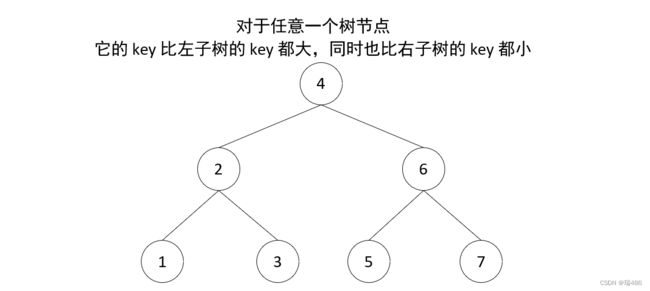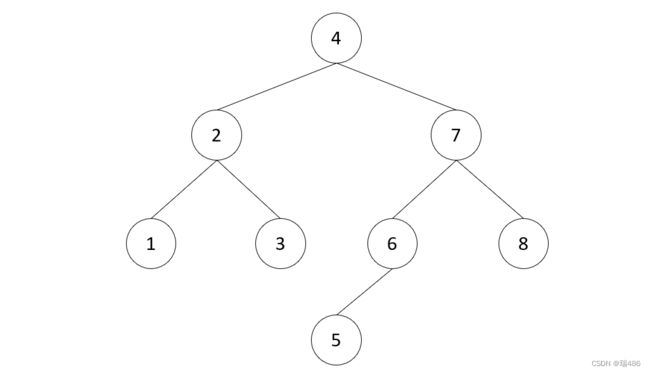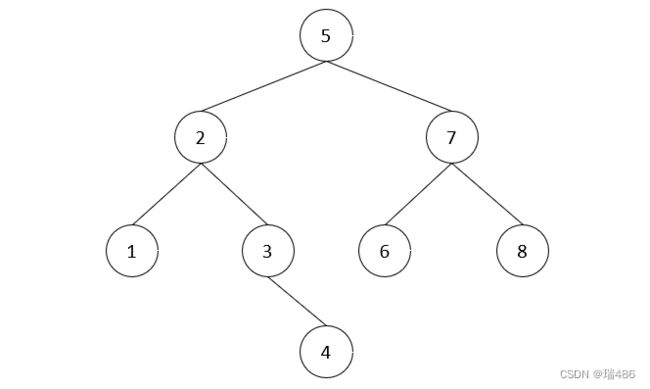瑞_数据结构与算法_二叉搜索树
文章目录
-
- 1 什么是二叉搜索树
-
- 1.1 二叉搜索树的特征
- 1.2 前驱后继
- 2 二叉搜索树的Java实现
-
- 2.1 定义二叉搜索树节点类BSTNode
-
- 泛型key改进
- 2.2 实现查找方法get(int key)
-
- 递归实现
- 非递归实现 ★
- 非递归实现 泛型key版本
- 2.3 实现查找最小方法min()
-
- 递归实现
- 非递归实现 ★
- 2.4 实现查找最大方法max()
-
- 递归实现
- 非递归实现 ★
- 2.5 实现新增方法put(int key, Object value)
-
- 递归实现
- 非递归实现 ★
- 2.6 实现查找关键字的前任值predecessor(int key)
- 2.7 查找关键字的后任值successor(int key)
- 2.8 根据关键字删除remove(int key)
-
- 非递归实现 ★
- 递归实现
- 3 二叉搜索树——范围查询
-
- 3.1 找所有小于索引的值less(int key)
- 3.2 找所有大于索引的值greater(int key)
- 3.3 找范围值between(int key1, int key2)
- 3.3 小结
前言:本文章为瑞_系列专栏之《数据结构与算法》的二叉搜索树篇。由于博主是从B站黑马程序员的《数据结构与算法》学习到的相关知识,所以本系列专栏主要针对该课程进行笔记总结和拓展,文中的部分原理及图解也是来源于黑马提供的资料。本文仅供大家交流、学习及研究使用,禁止用于商业用途,违者必究!
1 什么是二叉搜索树
二叉搜索树最早是由Bernoulli兄弟在18世纪中提出的,但是真正推广和应用该数据结构的是1960年代的D.L. Gries。他的著作《The Science of Programming》中详细介绍了二叉搜索树的实现和应用。
在计算机科学的发展中,二叉搜索树成为了一种非常基础的数据结构,被广泛应用在各种领域,包括搜索、排序、数据库索引等。随着计算机算力的提升和对数据结构的深入研究,二叉搜索树也不断被优化和扩展,例如AVL树、红黑树等。
1.1 二叉搜索树的特征
二叉搜索树(也称二叉排序树)是符合下面特征的二叉树:
- 树节点增加 key 属性,用来比较谁大谁小,key 不可以重复
- 对于任意一个树节点,它的 key 比左子树的 key 都大,同时也比右子树的 key 都小,例如下图所示:
轻易看出要查找 7 (从根开始)自然就可应用二分查找算法,只需三次比较
- 与 4 比,较之大,向右找
- 与 6 比,较之大,继续向右找
- 与 7 比,相等,即找到
查找的时间复杂度与树高相关,插入、删除也是如此。
- 如果这棵树长得还不赖(左右平衡)如上图,那么时间复杂度均是 O ( log N ) O(\log{N}) O(logN)
- 当然,这棵树如果长得丑(左右高度相差过大)如下图,那么这时是最糟的情况(链表),时间复杂度是 O ( N ) O(N) O(N)
注:
- 二叉搜索树 - 英文 binary search tree,简称 BST
- 二叉排序树 - 英文 binary ordered tree 或 binary sorted tree
二叉树的相关知识可以参考博客:《瑞_数据结构与算法_二叉树》
二分查找的相关知识可以参考博客:瑞_数据结构与算法_二分查找
1.2 前驱后继
- 前驱值(前任值):找到一个离该节点最近且比该节点存储值小的值
- 后继值(后任值):找到一个离该节点最近且比该节点存储值大的值
2 二叉搜索树的Java实现
以简单实现为主,主要是学习其思想,和Java中的Map集合实现的思维类似,通过key查找value
内部节点类BSTNode中含有属性:
- 索引
- 存储值
- 左孩子
- 右孩子
BSTTree二叉搜索树类含有方法:
- 查找关键字对应的值get(int key)
- 查找最小关键字对应值min()
- 查找最大关键字对应值max()
- 存储关键字和对应值put(int key, Object value)
- 查找关键字的前任值predecessor(int key)
- 查找关键字的后任值successor(int key)
- 根据关键字删除remove(int key)
2.1 定义二叉搜索树节点类BSTNode
BSTNode即二叉搜索树节点类(内部类),含有索引、存储值、左孩子、右孩子属性,由于是简单实现,索引定义基本数据类型(若希望任意类型作为 key,则后续可以将其设计为 Comparable 接口)
/**
* Binary Search Tree 二叉搜索树
*
* @author LiaoYuXing-Ray
* @version 1.0
* @createDate 2024/1/24 19:27
**/
public class BSTTree {
/**
* 根节点
*/
BSTNode root;
static class BSTNode {
// 索引,比较值
int key;
// 该节点的存储值
Object value;
// 左孩子
BSTNode left;
// 右孩子
BSTNode right;
public BSTNode(int key) {
this.key = key;
}
public BSTNode(int key, Object value) {
this.key = key;
this.value = value;
}
public BSTNode(int key, Object value, BSTNode left, BSTNode right) {
this.key = key;
this.value = value;
this.left = left;
this.right = right;
}
}
}
泛型key改进
使用泛型上限语法,让泛型的Key继承Comparable接口,使其能够进行大小比较。改进后代码如下(含get方法):
/**
* 二叉搜索树, 泛型 key 版本
*/
public class BSTTree<K extends Comparable<K>, V> {
static class BSTNode<K, V> {
K key;
V value;
BSTNode<K, V> left;
BSTNode<K, V> right;
public BSTNode(K key) {
this.key = key;
}
public BSTNode(K key, V value) {
this.key = key;
this.value = value;
}
public BSTNode(K key, V value, BSTNode<K, V> left, BSTNode<K, V> right) {
this.key = key;
this.value = value;
this.left = left;
this.right = right;
}
}
BSTNode<K, V> root;
public V get(K key) {
if (key == null) {
return null;
}
BSTNode<K, V> node = root;
while (node != null) {
int result = key.compareTo(node.key);
if (result < 0) {
node = node.left;
} else if (result > 0) {
node = node.right;
} else {
return node.value;
}
}
return null;
}
}
瑞:此处泛型没有定义为T而定义K,是因为K、V迎合map集合中的key,value,容易理解
2.2 实现查找方法get(int key)
get(int key)方法通过关键字查找对应的值
递归实现
get(int key)方法是通过key索引关键字查找对应的值,可以使用递归查找
/**
* 查找关键字对应的值
*
* @param key 关键字
* @return 关键字对应的值
*/
public Object get(int key) {
return doGet(root, key);
}
/**
* 私有 - 封装BSTNode参数,外部只需要调用get(int key)方法即可,不用关心具体细节
*
* @param node 根节点
* @param key 索引关键字
* @return java.lang.Object 关键字对应的值
* @author LiaoYuXing-Ray 2024/1/24 19:53
**/
private Object doGet(BSTNode node, int key) {
if (node == null) {
return null; // 没找到
}
if (key < node.key) {
return doGet(node.left, key); // 向左找
} else if (node.key < key) {
return doGet(node.right, key); // 向右找
} else {
return node.value; // 找到了
}
}
瑞:该递归实现是尾递归
尾递归是一种特殊形式的递归,它的特点是在函数的最后一步调用自身,并且不需要保留外层函数的调用记录。
注意区别伪递归,伪递归通常指的是使用迭代实现的递归算法,它们在逻辑上模拟了递归的过程,但实际上并不通过函数调用自身来实现。
尾递归的特点:
- 在函数的最后一步调用自身,不保留外层函数的调用记录。
- 可以仅使用常量级的栈空间,与迭代过程类似。
- 有着与循环同样优秀的计算性能。
伪递归的特点:- 使用迭代来模拟递归的逻辑。
- 不涉及实际的函数自我调用。
- 通常用于那些不支持尾递归优化的编程语言中,以减少内存消耗。
方法测试代码如下:
/**
* Binary Search Tree 二叉搜索树
*
* @author LiaoYuXing-Ray
* @version 1.0
* @createDate 2024/1/24 19:27
**/
public class BSTTree {
/**
* 根节点
*/
BSTNode root;
static class BSTNode {
// 索引,比较值
int key;
// 该节点的存储值
Object value;
// 左孩子
BSTNode left;
// 右孩子
BSTNode right;
public BSTNode(int key) {
this.key = key;
}
public BSTNode(int key, Object value) {
this.key = key;
this.value = value;
}
public BSTNode(int key, Object value, BSTNode left, BSTNode right) {
this.key = key;
this.value = value;
this.left = left;
this.right = right;
}
}
/**
* 查找关键字对应的值
* 递归实现
*
* @param key 关键字
* @return 关键字对应的值
*/
public Object get(int key) {
return doGet(root, key);
}
/**
* 私有 - 封装BSTNode参数,外部只需要调用get(int key)方法即可,不用关心具体细节
*
* @param node 根节点
* @param key 索引关键字
* @return java.lang.Object 关键字对应的值
* @author LiaoYuXing-Ray 2024/1/24 19:53
**/
private Object doGet(BSTNode node, int key) {
if (node == null) {
return null; // 没找到
}
if (key < node.key) {
return doGet(node.left, key); // 向左找
} else if (node.key < key) {
return doGet(node.right, key); // 向右找
} else {
return node.value; // 找到了
}
}
public static void main(String[] args) {
/*
4
/ \
2 6
/ \ / \
1 3 5 7
*/
BSTNode n1 = new BSTNode(1, "Ray1");
BSTNode n3 = new BSTNode(3, "Ray3");
BSTNode n2 = new BSTNode(2, "Ray2", n1, n3);
BSTNode n5 = new BSTNode(5, "Ray5");
BSTNode n7 = new BSTNode(7, "Ray7");
BSTNode n6 = new BSTNode(6, "Ray6", n5, n7);
BSTNode root = new BSTNode(4, "Ray4", n2, n6);
BSTTree tree = new BSTTree();
tree.root = root;
for (int i = 0; i <= 8; i++) {
System.out.println(tree.get(i));
}
}
}
运行结果如下,找不到索引为0和8的元素存储值,而1-7都能找到,符合预期:
null
Ray1
Ray2
Ray3
Ray4
Ray5
Ray6
Ray7
null
非递归实现 ★
由于之前使用的是尾递归实现,而尾递归转换成迭代法是非常容易的,性能上也能有所提升,所以一般情况下,如果使用尾递归都会转化为迭代法。
/**
* 查找关键字对应的值
* 非递归实现
*
* @param key 关键字
* @return 关键字对应的值
*/
public Object get(int key) {
BSTNode node = root;
while (node != null) {
if (key < node.key) {
// 向左找
node = node.left;
} else if (node.key < key) {
// 向右找
node = node.right;
} else {
// 找到
return node.value;
}
}
// 没找到
return null;
}
瑞:测试用例可以使用同一个,同样能通过,且性能更佳。
非递归实现 泛型key版本
如果希望让除 int 外更多的类型能够作为 key,一种方式是 key 必须实现 Comparable 接口。
由于compareTo方法返回-1,表示key < node.key,0表示key == node.key,1表示key > node.key,所以改进后代码如下:
public V get(K key) {
BSTNode<K, V> node = root;
while (node != null) {
/*
-1 key < p.key
0 key == p.key
1 key > p.key
*/
int result = key.compareTo(node.key);
if (result < 0) {
node = node.left;
} else if (result > 0) {
node = node.right;
} else {
return node.value;
}
}
return null;
}
还有一种做法不要求 key 实现 Comparable 接口,而是在构造 Tree 时把比较规则作为 Comparator 传入,将来比较 key 大小时都调用此 Comparator 进行比较,这种做法可以参考 Java 中的 java.util.TreeMap
方法测试代码如下:
/**
* 二叉搜索树, 泛型 key 版本
*/
public class BSTTree<K extends Comparable<K>, V> {
static class BSTNode<K, V> {
K key;
V value;
BSTNode<K, V> left;
BSTNode<K, V> right;
public BSTNode(K key) {
this.key = key;
}
public BSTNode(K key, V value) {
this.key = key;
this.value = value;
}
public BSTNode(K key, V value, BSTNode<K, V> left, BSTNode<K, V> right) {
this.key = key;
this.value = value;
this.left = left;
this.right = right;
}
}
BSTNode<K, V> root;
public V get(K key) {
if (key == null) {
return null;
}
BSTNode<K, V> node = root;
while (node != null) {
/*
-1 key < node.key
0 key == node.key
1 key > node.key
*/
int result = key.compareTo(node.key);
if (result < 0) {
node = node.left;
} else if (result > 0) {
node = node.right;
} else {
return node.value;
}
}
return null;
}
public static void main(String[] args) {
BSTNode<String,String> n1 = new BSTNode<>("a", "RayA");
BSTNode<String,String> n3 = new BSTNode<>("c", "RayC");
BSTNode<String,String> n2 = new BSTNode<>("b", "RayB", n1, n3);
BSTNode<String,String> n5 = new BSTNode<>("e","RayE");
BSTNode<String,String> n7 = new BSTNode<>("g","RayG");
BSTNode<String,String> n6 = new BSTNode<>("f", "RayF", n5, n7);
BSTNode<String,String> root = new BSTNode<>("d", "RayD", n2, n6);
BSTTree<String,String> tree = new BSTTree<>();
tree.root = root;
System.out.println(tree.get("a"));
System.out.println(tree.get("b"));
System.out.println(tree.get("c"));
System.out.println(tree.get("d"));
System.out.println(tree.get("e"));
System.out.println(tree.get("f"));
System.out.println(tree.get("g"));
System.out.println(tree.get("h"));
}
}
运行结果如下,符合预期:
RayA
RayB
RayC
RayD
RayE
RayF
RayG
null
2.3 实现查找最小方法min()
min()方法查找最小关键字key的对应存储值
递归实现
根据二叉搜索树的特征,树中最左的节点即为最小索引(关键字),即向左走到头即可,所以只要左孩子为null,即找到最小关键字,使用递归实现的代码就非常简单,如下:
/**
* 查找最小关键字对应值
* 递归实现
*
* @return 关键字对应的值
*/
public Object min() {
return doMin(root);
}
public Object doMin(BSTNode node) {
if (node == null) {
return null;
}
// 左边已走到头
if (node.left == null) {
return node.value;
}
return doMin(node.left);
}
非递归实现 ★
由于之前使用的是尾递归实现,所以下面转化为迭代法,代码如下:
/**
* 查找最小关键字对应值
* 非递归实现
*
* @return 关键字对应的值
*/
public Object min() {
return min(root);
}
private Object min(BSTNode node) {
if (node == null) {
return null;
}
BSTNode p = node;
// 左边未走到头
while (p.left != null) {
p = p.left;
}
return p.value;
}
方法测试代码如下:
public static void main(String[] args) {
/*
4
/ \
2 6
/ \ / \
1 3 5 7
*/
BSTNode n1 = new BSTNode(1, "Ray1");
BSTNode n3 = new BSTNode(3, "Ray3");
BSTNode n2 = new BSTNode(2, "Ray2", n1, n3);
BSTNode n5 = new BSTNode(5, "Ray5");
BSTNode n7 = new BSTNode(7, "Ray7");
BSTNode n6 = new BSTNode(6, "Ray6", n5, n7);
BSTNode root = new BSTNode(4, "Ray4", n2, n6);
BSTTree tree = new BSTTree();
tree.root = root;
System.out.println(tree.min());
}
运行结果如下,查找到最小(最左节点)索引key为1的存储值Ray1,符合预期:
Ray1
2.4 实现查找最大方法max()
max()方法查找最大关键字key的对应存储值
递归实现
与min()方法实现的思想类似,树中最右的节点即为最大索引(关键字),即向右走到头即可,所以只要右孩子为null,即找到最大关键字,使用递归实现的代码如下:
/**
* 查找最大关键字对应值
* 递归实现
*
* @return 关键字对应的值
*/
public Object max() {
return doMax(root);
}
public Object doMax(BSTNode node) {
if (node == null) {
return null;
}
// 右边已走到头
if (node.right == null) {
return node.value;
}
return doMax(node.right);
}
非递归实现 ★
由于之前使用的是尾递归实现,所以下面转化为迭代法,代码如下:
/**
* 查找最大关键字对应值
*
* @return 关键字对应的值
*/
public Object max() {
return max(root);
}
private Object max(BSTNode node) {
if (node == null) {
return null;
}
BSTNode p = node;
while (p.right != null) {
p = p.right;
}
return p.value;
}
方法测试代码如下:
public static void main(String[] args) {
BSTNode n1 = new BSTNode(1, "Ray1");
BSTNode n3 = new BSTNode(3, "Ray3");
BSTNode n2 = new BSTNode(2, "Ray2", n1, n3);
BSTNode n5 = new BSTNode(5, "Ray5");
BSTNode n7 = new BSTNode(7, "Ray7");
BSTNode n6 = new BSTNode(6, "Ray6", n5, n7);
BSTNode root = new BSTNode(4, "Ray4", n2, n6);
BSTTree tree = new BSTTree();
tree.root = root;
System.out.println(tree.max());
}
运行结果如下,查找到最大(最右节点)索引key为7的存储值Ray7,符合预期:
Ray7
2.5 实现新增方法put(int key, Object value)
新增put(int key, Object value)方法存储关键字和对应值,和Java中的Map的put方法类似,分为两种情况:
1️⃣ key在整个树中已经存在,新增操作变为更新操作,将旧的值替换为新的值
2️⃣ key在整个树中未存在,执行新增操作,将key value添加到树中
递归实现
递归实现思路如下:
- 若找到 key,走 else 更新找到节点的值
- 若没找到 key,走第一个 if,创建并返回新节点
- 返回的新节点,作为上次递归时 node 的左孩子或右孩子
- 缺点是,会有很多不必要的赋值操作
/**
* 存储关键字和对应值
* 递归实现
*
* @param key 关键字
* @param value 值
*/
public void put(int key, Object value) {
root = doPut(root, key, value);
}
private BSTNode doPut(BSTNode node, int key, Object value) {
if (node == null) {
return new BSTNode(key, value);
}
if (key < node.key) {
node.left = doPut(node.left, key, value);
} else if (node.key < key) {
node.right = doPut(node.right, key, value);
} else {
node.value = value;
}
return node;
}
缺点:此处return node返回当前节点会多出一些额外的赋值动作。如下面这颗二叉搜索树,1作为插入节点,1和2通过node.left = doPut(node.left, key, value);建立父子关系返回,这是有必要的,但是由于递归,2和5也会通过node.left = doPut(node.left, key, value);建立父子关系,这样就是没必要的(因为5和2原本就存在父子关系),如果树的深度很大,那就会浪费很多性能。
5
/ \
2 6
\ \
1 3 7
非递归实现 ★
查找逻辑和get方法的逻辑基本一样,区别是如果查找到值则更新node.value = value;,没查找到则新增。在新增时为了防止频繁的更新操作,添加parent父节点,判断新增节点是父节点的左孩子还是右孩子,然后再新增,代码如下:
/**
* 存储关键字和对应值
* 非递归实现
*
* @param key 关键字
* @param value 值
*/
public void put(int key, Object value) {
BSTNode node = root;
BSTNode parent = null; // 父节点
while (node != null) {
parent = node;
if (key < node.key) {
node = node.left;
} else if (node.key < key) {
node = node.right;
} else {
// 1. key 存在则更新
node.value = value;
return;
}
}
// 2. key 不存在则新增,判断新节点是父节点的左孩子还是右孩子
// parent 为空代表树为空的情况,那新增节点就是根节点
if (parent == null) {
root = new BSTNode(key, value);
}
// 新增节点为左孩子
else if (key < parent.key) {
parent.left = new BSTNode(key, value);
}
// 新增节点为右孩子
else {
parent.right = new BSTNode(key, value);
}
}
测试代码:
public static void main(String[] args) {
/*
4
/ \
2 6
/ \ / \
1 3 5 7
*/
BSTNode n1 = new BSTNode(1, "Ray1");
BSTNode n3 = new BSTNode(3, "Ray3");
BSTNode n2 = new BSTNode(2, "Ray2", n1, n3);
BSTNode n5 = new BSTNode(5, "Ray5");
BSTNode n7 = new BSTNode(7, "Ray7");
BSTNode n6 = new BSTNode(6, "Ray6", n5, n7);
BSTNode root = new BSTNode(4, "Ray4", n2, n6);
BSTTree createTree = new BSTTree();
createTree.root = root;
BSTTree tree = new BSTTree();
tree.put(4, new Object());
tree.put(2, new Object());
tree.put(6, new Object());
tree.put(1, new Object());
tree.put(3, new Object());
tree.put(5, new Object());
tree.put(7, new Object());
System.out.println(createTree == tree);
tree.put(1, "Ray486");
System.out.println(tree.get(1).equals("Ray486"));
}
两树的key一致但输出false,说明不是同样的树,索引1的存储值被成功替换,均符合预期,测试结果如下:
false
true
2.6 实现查找关键字的前任值predecessor(int key)
回顾跳转前驱后继
一个节点的前驱(前任)节点是指:比它小的节点中,最大的那个
一个节点的后继(后任)节点是指:比它大的节点中,最小的那个
例如上图中
- 1 没有前驱,后继是 2
- 2 前驱是 1,后继是 3
- 3 前驱是 2,后继是 4
想要找到二叉搜索树的某节点的前驱后继节点,简单(但不高效)的办法是中序遍历,即可获得排序结果,此时很容易找到前驱后继。因为使用中序遍历后二叉搜索树的值就是升序的,有了升序排序,前驱后继节点就很好找。但是,由于中序遍历的性能不高,所以不推荐使用。
要效率更高,需要研究一下规律,找前驱分成以下 2 种情况:
1️⃣节点 有 左子树,此时前驱节点就是左子树的最大值,图中属于这种情况的有:
- 2 的前驱是1
- 4 的前驱是 3
- 6 的前驱是 5
- 7 的前驱是 6
2️⃣节点 没有 左子树,若离它最近的祖先自从左而来,此祖先即为前驱,如:
- 3 的祖先 2 自左而来,前驱 2
- 5 的祖先 4 自左而来,前驱 4
- 8 的祖先 7 自左而来,前驱 7
- 1 没有这样的祖先,前驱 null
瑞:祖先不止是父节点,也可以是父节点的父节点,父节点的的父节点的父节点…
对于情况2,只需要添加一个指针,记录最近一个自左而来的祖先即可,实现代码如下:
/**
* 查找关键字的前任值
*
* @param key 关键字
* @return 前任值
*/
public Object predecessor(int key) {
BSTNode p = root;
// 自左而来的祖先
BSTNode ancestorFromLeft = null;
while (p != null) {
if (key < p.key) {
p = p.left;
} else if (p.key < key) {
// 记录自左而来的祖先
ancestorFromLeft = p;
p = p.right;
} else {
break;
}
}
// 没找到节点
if (p == null) {
return null;
}
// 找到节点 情况1:节点有左子树,此时前任就是左子树的最大值
if (p.left != null) {
return max(p.left);
}
// 找到节点 情况2:节点没有左子树,若离它最近的、自左而来的祖先就是前任
return ancestorFromLeft != null ?
ancestorFromLeft.value : null;
}
2.7 查找关键字的后任值successor(int key)
回顾跳转前驱后继
一个节点的前驱(前任)节点是指:比它小的节点中,最大的那个
一个节点的后继(后任)节点是指:比它大的节点中,最小的那个
与前驱类似找后继也分成 2 种情况:
1️⃣节点有右子树,此时后继节点即为右子树的最小值,如:
- 2 的后继 3
- 3 的后继 4
- 5 的后继 6
- 7 的后继 8
2️⃣节点没有右子树,若离它最近的祖先自右而来,此祖先即为后继,如:
- 1 的祖先 2 自右而来,后继 2
- 4 的祖先 5 自右而来,后继 5
- 6 的祖先 7 自右而来,后继 7
- 8 没有这样的祖先,后继 null
代码实现和前任类似,如下:
/**
* 查找关键字的后任值
*
* @param key 关键字
* @return 后任值
*/
public Object successor(int key) {
BSTNode p = root;
// 自右而来的祖先
BSTNode ancestorFromRight = null;
while (p != null) {
if (key < p.key) {
// 记录自右而来的祖先
ancestorFromRight = p;
p = p.left;
} else if (p.key < key) {
p = p.right;
} else {
break;
}
}
// 没找到节点
if (p == null) {
return null;
}
// 找到节点 情况1:节点有右子树,此时后任就是右子树的最小值
if (p.right != null) {
return min(p.right);
}
// 找到节点 情况2:节点没有右子树,若离它最近的、自右而来的祖先就是后任
return ancestorFromRight != null ?
ancestorFromRight.value : null;
}
2.8 根据关键字删除remove(int key)
删除remove(int key)方法需要考虑的情况较多。要删除某节点(称为 D),必须先找到被删除节点的父节点,这里称为 Parent,具体情况如下:
- 删除节点没有左孩子,将右孩子托孤给 Parent
- 删除节点没有右孩子,将左孩子托孤给 Parent
- 删除节点左右孩子都没有,已经被涵盖在情况1、情况2 当中,把 null 托孤给 Parent
- 删除节点左右孩子都有,可以将它的后继节点(称为 S)托孤给 Parent,设 S 的父亲为 SP,又分两种情况
- SP 就是被删除节点,此时 D 与 S 紧邻,只需将 S 托孤给 Parent
- SP 不是被删除节点,此时 D 与 S 不相邻,此时需要将 S 的后代托孤给 SP,再将 S 托孤给 Parent
删除本身很简单,只要通过索引查找到该节点删除即可,但是,由于需要料理后事,所以想要做好删除操作,需要处理好“托孤”操作。
非递归实现 ★
情况3走情况1或者情况2的逻辑都是可以的,所以不用管,主要是情况4的第二种子情况(删除和后继不相邻),需要处理好该情况下要删除节点的后任的托孤(利用后继节点不会有左孩子,如果有左孩子,那就不会是最小值,所以后继不可能有左孩子),再将后继节点托孤给被删除节点的父节点,代码如下:
/**
* 根据关键字删除
* 非递归实现
*
* @param key 关键字
* @return 被删除关键字对应值
*/
public Object remove(int key) {
BSTNode p = root;
// 记录待删除节点的父亲
BSTNode parent = null;
while (p != null) {
if (key < p.key) {
parent = p;
p = p.left;
} else if (p.key < key) {
parent = p;
p = p.right;
} else {
break;
}
}
if (p == null) {
return null;
}
// 删除操作
if (p.left == null) {
shift(parent, p, p.right); // 情况1
} else if (p.right == null) {
shift(parent, p, p.left); // 情况2
} else {
// 情况4
// 4.1 被删除节点找后继
BSTNode s = p.right;
BSTNode sParent = p; // 后继父亲
while (s.left != null) {
sParent = s;
s = s.left;
}
// 4.2 删除和后继不相邻, 处理后继的后事
if (sParent != p) {
shift(sParent, s, s.right); // 不可能有左孩子(否则就不是后继节点)
s.right = p.right;
}
// 4.3 后继取代被删除节点
shift(parent, p, s);
s.left = p.left;
}
return p.value;
}
/**
* 托孤方法
*
* @param parent 被删除节点的父亲
* @param deleted 被删除节点
* @param child 被顶上去的节点
*/
// 只考虑让 n1父亲的左或右孩子指向 n2, n1自己的左或右孩子并未在方法内改变
private void shift(BSTNode parent, BSTNode deleted, BSTNode child) {
if (parent == null) {
// 根节点(特殊情况)
root = child;
} else if (deleted == parent.left) {
parent.left = child;
} else {
parent.right = child;
}
}
测试代码:
public static void main(String[] args) {
/*
4
/ \
2 7
/ \ /
1 3 6
/
5
*/
BSTNode n1 = new BSTNode(1, 1);
BSTNode n3 = new BSTNode(3, 3);
BSTNode n2 = new BSTNode(2, 2, n1, n3);
BSTNode n5 = new BSTNode(5, 5);
BSTNode n6 = new BSTNode(6, 6, n5, null);
BSTNode n7 = new BSTNode(7, 7, n6, null);
BSTNode root1 = new BSTNode(4, 4, n2, n7);
BSTTree tree1 = new BSTTree();
tree1.root = root1;
Object delete = tree1.remove(7);
System.out.println(delete + "\t" + 7); // 7 7
// 删除后
/*
4
/ \
2 6
/ \ /
1 3 5
*/
BSTNode x1 = new BSTNode(1, 1);
BSTNode x3 = new BSTNode(3, 3);
BSTNode x2 = new BSTNode(2, 2, x1, x3);
BSTNode x5 = new BSTNode(5, 5);
BSTNode x6 = new BSTNode(6, 6, x5, null);
BSTNode root2 = new BSTNode(4, 4, x2, x6);
BSTTree tree2 = new BSTTree();
tree2.root = root2;
System.out.println(isSameTree(tree1.root,tree2.root)); // true
}
// 判断是否为同一树(key对应的value都相等)
static boolean isSameTree(BSTNode tree1, BSTNode tree2) {
if (tree1 == null && tree2 == null) {
return true;
}
if (tree1 == null || tree2 == null) {
return false;
}
if (tree1.key != tree2.key) {
return false;
}
return isSameTree(tree1.left, tree2.left) && isSameTree(tree1.right, tree2.right);
}
测试结果如下,删除的元素符合预期,且删除后的树与预期结果的结构一致
7 7
true
递归实现
由于递归实现效率低,且较难理解,主要是为了结合非递归实现提供思路,可以结合注释思考,不过多讲解,代码如下:
/**
* 根据关键字删除
* 递归实现
*
* @param key 关键字
* @return 被删除关键字对应值
*/
public Object remove(int key) {
ArrayList<Object> result = new ArrayList<>(); // 保存被删除节点的值
root = doRemove(root, key, result);
return result.isEmpty() ? null : result.get(0);
}
/**
* 私有 递归删除具体实现细节
*
* @param node 起点
* @param key 删除索引
* @param result 保存被删除节点的值
* @return node 删剩下的孩子(找到) 或 null(没找到)
* @author LiaoYuXing-Ray 2024/1/25 19:59
**/
private BSTNode doRemove(BSTNode node, int key, ArrayList<Object> result) {
if (node == null) {
return null;
}
if (key < node.key) {
node.left = doRemove(node.left, key, result);
return node;
}
if (node.key < key) {
node.right = doRemove(node.right, key, result);
return node;
}
result.add(node.value);
if (node.left == null) { // 情况1 - 只有右孩子
return node.right;
}
if (node.right == null) { // 情况2 - 只有左孩子
return node.left;
}
BSTNode s = node.right; // 情况3 - 有两个孩子
while (s.left != null) {
s = s.left;
}
s.right = doRemove(node.right, s.key, new ArrayList<>());
s.left = node.left;
return s;
}
说明
ArrayList用来保存被删除节点的值- 第二、第三个 if 对应没找到的情况,继续递归查找和删除,注意后续的 doRemove返回值代表删剩下的,因此需要更新
- 最后一个 return 对应删除节点只有一个孩子的情况,返回那个不为空的孩子,待删节点自己因没有返回而被删除
- 第四个 if 对应删除节点有两个孩子的情况,此时需要找到后继节点,并在待删除节点的右子树中删掉后继节点,最后用后继节点替代掉待删除节点返回,别忘了改变后继节点的左右指针
3 二叉搜索树——范围查询
4
/ \
2 6
/ \ / \
1 3 5 7
3.1 找所有小于索引的值less(int key)
less(int key)方法:找 < key 的所有 value
使用中序遍历
// 找 < key 的所有 value
public List<Object> less(int key) {
ArrayList<Object> result = new ArrayList<>();
BSTNode p = root;
LinkedList<BSTNode> stack = new LinkedList<>();
while (p != null || !stack.isEmpty()) {
if (p != null) {
stack.push(p);
p = p.left;
} else {
BSTNode pop = stack.pop();
// 处理值
if (pop.key < key) {
result.add(pop.value);
} else {
break;
}
p = pop.right;
}
}
return result;
}
3.2 找所有大于索引的值greater(int key)
greater(int key)方法:找 > key 的所有 value
使用常规的中序遍历(从左向右的中序遍历)
public List<Object> greater(int key) {
ArrayList<Object> result = new ArrayList<>();
BSTNode p = root;
LinkedList<BSTNode> stack = new LinkedList<>();
while (p != null || !stack.isEmpty()) {
if (p != null) {
stack.push(p);
p = p.left;
} else {
BSTNode pop = stack.pop();
if (pop.key > key) {
result.add(pop.value);
}
p = pop.right;
}
}
return result;
}
中序遍历效率不高,可以用 RNL 遍历(中序遍历的逆操作)
注:
- Pre-order, NLR
- In-order, LNR
- Post-order, LRN
- Reverse pre-order, NRL(反向前序遍历,值右左)
- Reverse in-order, RNL(反向中序遍历,右值左)
- Reverse post-order, RLN(反向后续序遍历,右左值)
RNL 遍历代码如下:
// 找 > key 的所有 value
public List<Object> greater(int key) {
ArrayList<Object> result = new ArrayList<>();
BSTNode p = root;
LinkedList<BSTNode> stack = new LinkedList<>();
while (p != null || !stack.isEmpty()) {
if (p != null) {
stack.push(p);
p = p.right;
} else {
BSTNode pop = stack.pop();
if (pop.key > key) {
result.add(pop.value);
} else {
break;
}
p = pop.left;
}
}
return result;
}
3.3 找范围值between(int key1, int key2)
between(int key1, int key2)方法:找 >= key1 且 <= key2 的所有值
// 找 >= key1 且 <= key2 的所有值
public List<Object> between(int key1, int key2) {
ArrayList<Object> result = new ArrayList<>();
BSTNode p = root;
LinkedList<BSTNode> stack = new LinkedList<>();
while (p != null || !stack.isEmpty()) {
if (p != null) {
stack.push(p);
p = p.left;
} else {
BSTNode pop = stack.pop();
// 处理值
if (pop.key >= key1 && pop.key <= key2) {
result.add(pop.value);
} else if (pop.key > key2) {
break;
}
p = pop.right;
}
}
return result;
}
测试:
public static void main(String[] args) {
/*
4
/ \
2 6
/ \ / \
1 3 5 7
*/
BSTNode n1 = new BSTNode(1, 1);
BSTNode n3 = new BSTNode(3, 3);
BSTNode n2 = new BSTNode(2, 2, n1, n3);
BSTNode n5 = new BSTNode(5, 5);
BSTNode n7 = new BSTNode(7, 7);
BSTNode n6 = new BSTNode(6, 6, n5, n7);
BSTNode root = new BSTNode(4, 4, n2, n6);
BSTTree tree = new BSTTree();
tree.root = root;
System.out.println(tree.less(6));
System.out.println(tree.greater(6));
System.out.println(tree.between(3,5));
}
输出如下,符合预期
[1, 2, 3, 4, 5]
[7]
[3, 4, 5]
3.3 小结
优点:
- 如果每个节点的左子树和右子树的大小差距不超过一,可以保证搜索操作的时间复杂度是 O(log n),效率高。
- 插入、删除结点等操作也比较容易实现,效率也比较高。
- 对于有序数据的查询和处理,二叉查找树非常适用,可以使用中序遍历得到有序序列。
缺点:
- 如果输入的数据是有序或者近似有序的,就会出现极度不平衡的情况,可能导致搜索效率下降,时间复杂度退化成O(n)。
- 对于频繁地插入、删除操作,需要维护平衡二叉查找树,例如红黑树、AVL 树等,否则搜索效率也会下降。
- 对于存在大量重复数据的情况,需要做相应的处理,否则会导致树的深度增加,搜索效率下降。
- 对于结点过多的情况,由于树的空间开销较大,可能导致内存消耗过大,不适合对内存要求高的场景。
瑞:关于二叉搜索树的练习可以结合《瑞_力扣LeetCode_二叉搜索树相关题》
如果觉得这篇文章对您有所帮助的话,请动动小手点波关注,你的点赞收藏⭐️转发评论都是对博主最好的支持~




